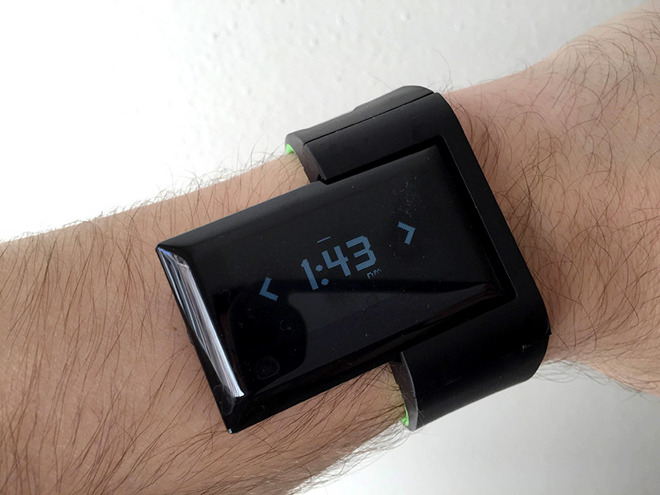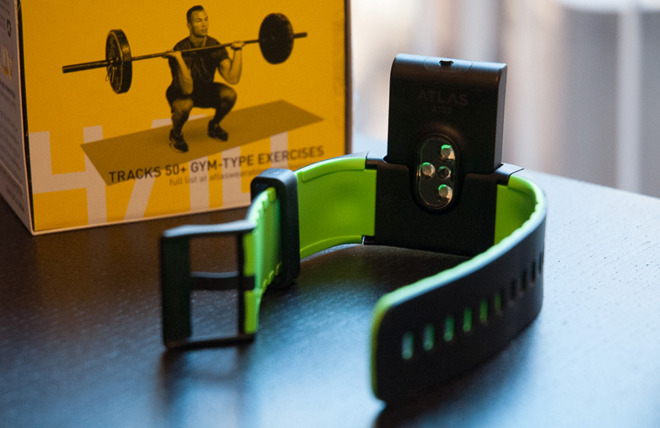The Atlas Wristband is a noble first effort at something no other fitness tracker does, but there are too many rough edges to recommend it to anyone but a small subset of fitness enthusiasts.

Until now, the biggest gap in fitness tracking has been weightlifting and other forms of strength training. Most trackers and smartwatches are geared towards walking and running, with cycling or swimming being an occasional bonus. By extension this limits wearers mostly to endurance and weight loss, rather than building muscle.
While steps and strokes are relatively easy to capture, the motions in strength training can be complex and varied, never mind recording weights themselves. Earlier efforts at tracking weightlifting were cumbersome at best, for instance asking people to clip a sensor onto a barbell.
Basics
The Atlas Wristband takes a very different and more practical approach, analyzing wrist motions in 3D space and comparing them against a library of common exercises. A bench press should, for example, trace a unique path compared to a curl or a squat.
The Atlas is so narrowly focused on this task that while it does have a heartrate sensor, it doesn't track steps at all, and doesn't have GPS. It also lacks smartphone notifications, and even its watch mode feels like more of an afterthought -- there's no wrist-wake gesture, so to check the time it's often just as fast to pull out your phone.

Indeed, Atlas admits on its website that the product isn't meant to be worn as an all-day device. Instead it's best strapped on for individual workouts and taken off immediately afterwards -- battery life is limited and while the device is water-resistant, it's not designed to be worn in the shower.

To make things slightly easier, the tracking module can be separated from the rest of the band for charging and cleaning, as it's just held in place with a magnetic lock. You can then take the strap into the shower, and simply wipe down the tracker before plugging in a micro-USB cable.
The Atlas app
Before even getting into a workout, the first stop is the Atlas mobile app. This is where you sync data and firmware updates, create or select a Coach Mode workout, and pick from a range of exercises for Freestyle Mode.
In general, the app is one of the more impressive parts of the Wristband. It's very clearly laid out, with almost obsessive levels of detail about recorded workouts, including heartrate charts, calories burned, reps and weights, and which muscle groups were used in what percentages. HealthKit support is missing, but that's not such a big deal given that heartrate data is the only thing that would carry over.
Coach Mode bundles together preset groups of exercises with interwoven rest times. A few dozen routines are included by default, divided into broader workout programs. Customization lets users build both programs and discrete routines, and if you're not sure how to do a particular exercise, a video guide is available so long as you have an Internet connection. Freestyle Mode lets users pick up to 15 exercises from the app's greater database and sync them for on-the-fly workouts.
If there's problem with the app itself, it's in how workout summaries are presented. We often had to force the latest one to appear by scrolling back and forth, and there's no monthly calendar for jumping to a specific date. That, however, is just the tip of the iceberg in terms of the wristband's issues.
In the gym
To start with, Power Save Mode was on by default on our model, and disabling it is an absolute must -- we can't overstate this. The screen is otherwise prone to shutting off when you're resting between sets, and sometimes this means it will treat (and sync) each new set as a separate workout. Until we discovered this, the wristband was on its way to a rock-bottom review score.
Starting a workout is relatively simple, as it should be, and once active just about everything you need is onscreen simultaneously, thanks to the wristband's unusual aspect ratio. Time and heartrate are always visible, while Coach Mode adds the current exercise, target reps and weight, and a rest countdown once a set is complete.
When everything works, it feels like magic. This is particularly true in Coach Mode, since in theory it means never having to carry a workout log again, or even count reps -- the device vibrates when a set is complete.
Its heartrare sensor is also one of the better ones out there. We compared it against the Polar A360 we reviewed in January, wearing both products simultaneously during some intense workouts (more on this later). While the two devices often gave nearly identical results, the Atlas was quicker to react and seemed more in line with how blood was actually pumping.
Hurdles
One significant problem is that unless your form is on-point and always conistent, the wristband will still make a few counting mistakes each workout, whether under or over your real totals. In our experience it's also more accurate with some exercises than others -- while bench presses are usually dead-on for example, exercises like burpees or squat lifts can be troublesome. You can at least edit reps on the device (immediately after a set) or in the app (after a workout).
Even without accuracy issues, the device still asks you to input weight values for every set. This is necessary, since there's no way for it to gauge how heavy a barbell is, but may be too tedious for some people, especially when you could be using another app (or just paper and pencil) to accomplish the same thing.
Atlas asks you to input weight values for every set, a task that can't yet be automated but is perhaps too tedious for casual users. It's difficult to find value in a pricey tech solution when similar results can be achieved with a pencil and some paper.
On a deeper level, some of Atlas' design decisions signal that the wristband wasn't designed for serious weighlifters. Occasionally for example, our unit would interpret motions between sets -- like reracking weights -- as a rep. The rest times in Coach Mode workouts don't scale to the amount of weight you're using, and that's critical, given that someone squatting 300 pounds will probably need a lot more than 20 seconds between sets.
The included workout regimes are fine in principle, but they're obviously designed for beginners and not terribly useful past that level. Each daily routine is short -- under 30 minutes or less -- and the default weights are often way too low for people with experience. There's no sign of any common programs with more growth potential, like ICF or Starting Strength.
You can try to recreate such programs on your own, but there are notable gaps in Atlas' exercise database. There's no sign of exercises like cable crunches, hyperextensions, or cable tricep pulldowns, among some other staples of the gym world. Somehow TRX (suspension cable) support was a higher priority.
To top things off, while the strap on the device is rugged and secure, it has to be fastened very tightly for the heartrate sensor to work, and becomes uncomfortable if worn for long stretches. You also have to wear it on your left wrist, since Atlas' tracking algorithms aren't yet ambidextrous.
Conclusions
Ultimately, it's difficult to recommend the Atlas Wristband to many people, at least in its present state. Veteran weightlifters aren't accommodated, and novices who can afford the device's $249 pricetag are probably better off hiring a trainer for a few sessions, or at least buying an armband for their phone and downloading StrongLifts 5x5.
Buried underneath it all, though, is a kernel of potential. One could easily imagine a second-gen device solving most issues and cornering the market on strength training. In that sense, we really hope the current one finds a market.
Score: 2.5 out of 5
Pros:- One-of-a-kind strength training functions
- Thorough, well-designed mobile app
- Above-average heartrate tracking
- Handy onscreen info during workouts
- Motion tracking not accurate enough
- Geared towards newcomers to strength training
- Crippling Power Save Mode on by default
- Strap not comfortable for long stretches
- Expensive
Where to buy:
The Atlas Wristband is available from Amazon or the Atlas website for $249.